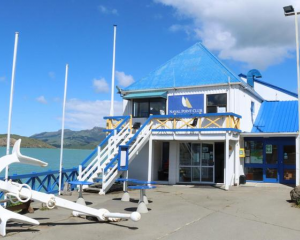On Sundays, Wilson can often be found taking people for rides at the Canterbury Society of Model and Experimental Engineers miniature train tracks at the Halswell Domain.
The Spreydon resident spent nine years sporadically building the train from scratch, one of up to 40 that use the tracks.
The effort paid off when he snared three awards at the club prize-giving last year, for best first model, best workmanship in any model and best overall model.
Hunter was pleased with his first foray into making miniature trains.
“They’ve got pride of place in our lounge,” he said.

The trains were made using Duke Class boilers on Bulldog Class frames, giving them their distinctive name.
Building the model had been challenging for the self-described hobbyist engineer.
He based his work off drawings of the original Dukedogs.
“You’re making it from a drawing, but the drawing doesn’t overly tell you how it’s constructed, so you’ve got to use your imagination a wee bit.”
One component that was especially difficult to make was the copper boiler, which needed to be carefully shaped.
Started with “great gusto” last year, the boiler underwent several setbacks as Hunter struggled to make it watertight.
“It took a number of weeks but eventually got there.”
Steam trains were a lifelong fascination for Hunter.
As a child, Thomas the Tank Engine first captured his imagination as he steamed across the television screen.
He had also enjoyed trips to Auckland’s Museum of Transport and Technology as a boy.

Operating the train was his favourite part of the process, as he could see the smile it put on people’s faces.
The Dukedog could pull one carriage with about five people on it, he said.
People who came to the domain on running days would take plenty of interest and ask questions, especially children.
“It’s quite a buzz . . . when people ask interesting questions about it.
“Intrigued kids are coming out and looking over things, I think I was the same at that age. It’s always quite good to keep that sort of tradition going.”
The question he was asked most often was whether his model used real coal.

‘It’s just a clean chimney really, there’s no smoke coming out of it or anything, just a bit of steam.”
In the Covid-19 red traffic light setting the tracks were temporarily closed, but on a typical Sunday they drew an average of about 500 people, he said.
Anywhere from 10 to 30 club members would also attend.
Although model trains were still a niche market in New Zealand, it was becoming more popular, he said.
“In the early days, it was [people] building things in their kitchens after dinner.
“Now, a lot of them have grown to become quite big organisations . . . Halswell is definitely one of the larger ones in New Zealand.
“It’s great to see, and they’re well supported by the public.”

He would enjoy making longer trips around the track on the Dukedog, which at full speed ran at between 10 and 15km/h.
“Model stuff, you don’t want to take them too fast.
“Model steam locomotives surprisingly can be actually quite intense to run because the parameters are so fine of them. You can run out of steam quite quickly.”
Soon Hunter would have a second train to run on the tracks.
He had nearly finished building a diesel model, a much easier task than making a steam model.
“They are a matter of months to put one of those together.
“I only started that in August, so it’s come together reasonably quickly.”
His interest in steam transport was not limited to models.
As part of the Ferrymead’s Tramway Historical Society, he also looked after the Kitson Steam Tram.
For the last five years, the Kitson had been undergoing an upgrade, including bodywork and a refurbished boiler that had not been in service since 1952.
“We’ve nearly completed an overhaul and we’re going to launch it again in a couple of month’s time.”













